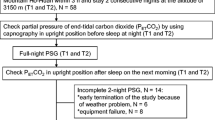Abstract
Background: The increasing popularity of mountain climbing will result in greater numbers of the general population being at risk for the disturbances known to occur with altitude exposure. Methods: Observations of sleep and breathing were made in 6 healthy travellers (5 males and 1 female, 38 to 62 years of age) before, during, and after a recreational climb. We modified a portable seven channel polygraph to record sleep state, oxygen saturation, respiratory movements, body position, and oronasal airflow 4 weeks prior to the expedition at home (500m), at base camp (4200m) and in 3 climbers at 6400m. All had a repeat study at 500m altitude 4 weeks after the expedition. Results: For the group, the total number of obstructive apneas and hypopneas (OA/H) at night increased from 36 at home to 68 at base camp over a one night recording. Separately counted central apneas and hypopneas (CA/CS) increased from 6.7 to 45. In one climber, who had a history of recurrent snoring and observed apneas at home, the number of apneas increased from 201 at 4200m to 322 at 6400m, whereas in 2 climbers measured at 6400m, all apneas decreased. The total sleep time (TST) increased in all 6 climbers by 10% at base camp in comparison to home records. In the 3 climbers attaining an altitude of 6400m, the REM (rapid eye movement) sleep declined by 10% compared to the record at 4200m. Conclusion: Respiratory disturbances at low altitude are amplified by exposure to high and extreme altitude. In those without symptoms of sleep apnea, significant physiologic alterations will occur at high altitude but at extreme altitude regular ventilation is re-established.
Similar content being viewed by others
References
Douglas CG, Haldane JS. The causes of periodic or Cheyne Stokes breathing. J Physiol 1909;38:404–419
Douglas CG, Haldane JS, Henderson Y, Schneider EC. Physiological observations made on Pikes Peak, Colorado, with special reference to adaptation to low barometric pressures. Pilos Trans R Soc Lond Biol 1913;203:185–381
Mosso A. Respiration on the mountains. In: Life of Man on the High Alps. London: Fischer Unwin; 1898: pp 31–50
Lahiri S, Mulligan E, Mokashi A. Adaptive responses of carotid body chemoreceptors to CO2. Brain Res 1982;234:137–147
LöUschke HH. Respiratory chemosensitivity in the medulla oblongata. Acta Neurobiol Exp 1973;33:97–112
SchläUfke ME. Central chemosensitivity: A respiratory drive. Rev Physiol Biochem Pharmacol 1981;90:171
Reite M, Jackson D, Cahoon RL, Weil JV. Sleep physiology at high altitude. Electroencephalogr Clin Neurophysiol 1975;38:463–471
Coote JH. Sleep at high altitude. In: Cooper R, ed. Sleep. London: Chapman and Hall 1994: pp 243–246
Nicholson AN, Smith PA, Stone BM. Altitude insomnia: Studies during an expedition to the Himalayas. Sleep 1988;11:354–361
Pappenheimer JR. Sleep and respiration of rats during hypoxia. J Physiol 1977;266:191–207
Lahiri S, Barnard P. Role of arterial chemoreflexes in breathing during sleep at high altitude. In: Sutton JS, Houston CS, Jones NL, eds. Hypoxia, Exercise and Altitude. New York: Lis 1983: pp 75–85
Douglas NJ, White DP, Weil JV, et al. Hypoxic ventilatory response decreases during sleep in normal men. Am Rev Respir Dis 1982;125:286–289
Milledge JS, Lahiri S. Respiratory control in lowlanders and Sherpa highlanders at altitude. Respir Physiol 1967;2:310–322
Lahiri S, DeLaney RG, Brody JS, et al. Relative role of environmental and genetic factors in respiratory adaptation to high altitude. Nature 1976;261:133–135
Finnegan TP, Abraham P, Docherty TB. Ambulatory monitoring of the electroencephalogram in high altitude mountaineers. Electroencephalogr Clin Neurophysiol 1985;60:220–224
Anholm JD, Powles ACP, Downey R, et al. Operation Everest II: Arterial oxygen saturation and sleep at extreme simulated altitude. Am Rev Respir Dis 1992;145:817–826
Weil JV. Sleep at high altitude. In: Kryger MH, Roth T, Dement WC, eds. Principles and Practice of Sleep Medicine. Philadelphia: WB Saunders 1993: pp 269–275
Young T, Palta M, Dempsey J, et al. The occurrence of sleep disordered breathing among middle aged adults. New Engl J Med 1993;328:1230–1235
Strohl KP, Beall CM, Decker MJ, Brittenham G. Quantitative genetic analysis of hypoxic ventilatory response at 4000m. Am J Resp Crit Care Med 1995;151:634 (A)
Salvaggio A, Insalaco G, Romano S, et al. Periodic breathing during nonREM sleep before and after acclimatization at high altitude. Am J Resp Crit Care Med 1995;151:634 (A)
Askenasy JJM, Goldstein R. Environment and sleep: Does a subtropical climate imply a seasonal rhythm in REM sleep. Sleep 1995;18:895–900
Author information
Authors and Affiliations
Rights and permissions
About this article
Cite this article
Netzer, N.C., Strohl, K.P. Sleep and Breathing in Recreational Climbers at an Altitude of 4200 and 6400 Meters: Observational Study of Sleep and Patterning of Respiration During Sleep in a Group of Recreational Climbers. Sleep Breath 3, 75–82 (1999). https://doi.org/10.1007/s11325-999-0075-7
Issue Date:
DOI: https://doi.org/10.1007/s11325-999-0075-7




